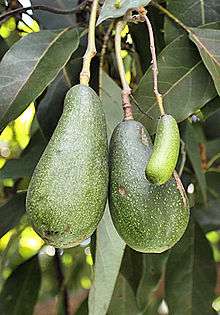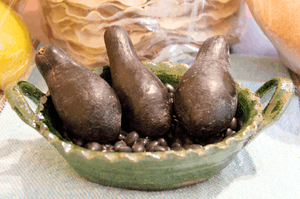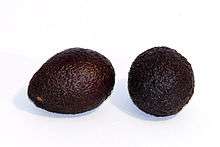Avocado production in Mexico
Avocado production is important to the economy of Mexico with the country being the world's largest producer of the crop.[1][2] Mexico supplies 45 percent of the international avocado market.[3] Of the 57 avocado producing countries, the other major producers are Dominican Republic, Peru, Colombia, and Indonesia in that order.[4]

The 'Avocado Belt of the Mexican Republic' includes Michoacán and the State of Mexico.[5] The major cultivars in Mexico are Fuerte, Hass, Bacon, Reed, Criollor, and Zutano.[6]
Background
Avocado is native to Central Mexico where its ancient history, established by archaeological evidence from Claude Earle Smith Jr., who discovered avocado cotyledon remains within deposits of the Coxcatlán Cave, in Tehuacán, in Puebla state, that date back to about 10,000 years ago. Nuevo León state has remnants of primitive avocado trees.[7] It spread to other countries in the Americas including the United States. It is a "functional food" in the Americas; the many varieties which grow in Mexico suit the climatic conditions.[7]
Ancient residents of Mexico including the Aztecs and other indigenous groups thought that the form of a fruit contributed to its properties[8]. Therefore, eating avocado promoted strength and virility. 16th century Spanish colonial documentation of Indian medicinal plant usage reaffirms this association, noting the fruit’s reputation as an aphrodisiac, as well as its propensity for aiding childbirth and reducing inflammation and indigestion[8]. The avocado likely also held cultural meaning for the Maya, who believed in the rebirth of their ancestors as trees and were therefore known to surround their houses with fruit trees, including avocados[9].

In the 1950s, orchards of Fuerte cultivar were established; two decades later, orchards of Hass cultivar were established and it became the country's leading cultivar.[5] This cultivar emerged when a postal worker in Southern California, Rudolph Hass, took a leap of faith to purchase a small 1.5-acre grove in La Habra Heights to experiment with growing high yield avocado trees. The graft he settled upon and patented in 1935 was predominantly Guatemalan with some Mexican genes[10]. It produced fruits that were a darker shade of purple than many were accustomed to, but was tastier, less oily, and kept better. Hass’ profits from his patent through its expiration in 1960 summed a meager $4800[11]. Today, more than 85% of avocados grown globally are of the Hass variety[10]. Hass avocados have shown susceptibility to pests such as Persea mites and avocado thrips[10].
In 2007, the avocado was Mexico’s fifth ranked fruit crop.[3] Being a staple food, the majority of avocados produced in Mexico are consumed in the country. Fresh domestic consumption for 2010-11 was forecast at 806,119 metric tons (888,594 short tons; 793,388 long tons), representing an 8.45 percent increase over the previous year.[12]
Production

Mexican avocado production is concentrated in Michoacán state in west central Mexico. Accounting for 92% of the country's production of the crop, Michoacán leads the world in avocado production, with approximately 106,000 hectares (260,000 acres).[12] The yield reported from Michoacán is 4 metric tons per hectare (1.6 long ton/acre; 1.8 short ton/acre) and can reach up to 8 metric tons per hectare (3.2 long ton/acre; 3.6 short ton/acre), much higher than comparable figures in the U.S. state of California.[13]
The favourable conditions for large production in the country is on account of availability of land, cheap labour, and rainfall pattern.[13] Harvesting techniques incorporate hand‐held poles and baskets, picking the crop when it is mature, though still hard.[3] In 1985, production estimates were 401,000 metric tons (442,000 short tons; 395,000 long tons).[5]
During the period 2001 to 2011, its production increased from 9,400,000 metric tons (10,400,000 short tons; 9,300,000 long tons) to 12,640,000 metric tons (13,930,000 short tons; 12,440,000 long tons). During the same period, exports from Mexico, which was the largest among all countries, increased from 893,000 metric tons (984,000 short tons; 879,000 long tons) to 3,470,000 metric tons (3,830,000 short tons; 3,420,000 long tons). As of 2003, the land area under this cultivar was 348,769 ha (861,830 acres) with a production of 2,583,226 metric tons (2,847,519 short tons; 2,542,428 long tons) a year.[7]
As of 2013, FAO reported 21,511 producers of avocado in Mexico out of which 10,000 were from Michoacán. This also created 279 packinghouses and domestic traders and 17 packinghouses/exporters. Fourteen processing industries came to be established which produced products such as guacamole, pulp, halves, frozen products, beverages and non-refined oil. These activities created more than 40,000 direct jobs, about 70,000 seasonal jobs, and more than 180,000 indirect permanent jobs.[7]
Tancítaro, Michoacán has declared itself "the avocado capital of the world"[14][15] and holds an annual Avocado Festival.[16]
Exports
Its export potential is constrained due to the quality of the product.[13] Exports increased more than 4-fold in the period from 2000 to 2011,[13] and in 2011 it accounted for 27.45 percent of its total production of 12,640,000 metric tons (13,930,000 short tons; 12,440,000 long tons).[4] Its export in the raw form is limited due to the problem of several species of avocado weevils. Beginning in 1914, the US began restricting avocado imports to reduce the chances of weevil outbreaks.[13] These restrictions were eliminated in 1997[17], building on momentum from the North American Free Trade Agreement to encourage cross-continental exchange. Avocado products like avocado pulp, avocado paste and guacamole are more popular for exports, and in this form its export to the US matched the import of value of all imported fresh avocados.[13] The exports of avocados from Mexico in the U.S reached 1.7 Billion in 2016, according to AFM, as American per capita consumption of avocados has increased seven-fold from 2000-2016[17].
References
- U.S. Department of Agriculture 2001, p. 19.
- Yun, Wonjung (June 14, 2018). "Rising Demand for Avocado: What to expect in 2018?". Tridge. Retrieved June 14, 2018.
- Jeansonne, Brent (June 1, 2011). "Commercial Horticulture: What do we know about Mexico's avocado production?" (PDF). University of Florida. Archived from the original (PDF) on 2013-10-12.
- "Avocado Statistics". Statista. Retrieved 26 March 2018.
- Sanchez Colin & Barrientos Priego 1987, pp. 24-26.
- Ray 2002, p. 269.
- "AvocadoPost-harvest Operations" (PDF). FAO organization of the World Bank. Retrieved 6 October 2013.
- Gutiérrez, M. L. (November 2007). "THE AVOCADO IN THE PREHISPANIC TIME" (PDF). Proceedings VI World Avocado Congress.
- Galindo-Tovar, María Elena; Ogata-Aguilar, Nisao; Arzate-Fernández, Amaury M. (2007-06-30). "Some aspects of avocado (Persea americana Mill.) diversity and domestication in Mesoamerica". Genetic Resources and Crop Evolution. 55 (3): 441–450. doi:10.1007/s10722-007-9250-5. ISSN 0925-9864.
- Ayala Silva, Tomas; Ledesma, Noris (2014). Sustainable Development and Biodiversity. Cham: Springer International Publishing. pp. 157–205. doi:10.1007/978-3-319-06904-3_8. ISBN 9783319069036.
- "Gardening: 'Hass' avocado patent didn't earn Rudolph Hass as much as he hoped". Daily News. 2017-07-02. Retrieved 2018-06-06.
- Hernandez, Gabriel (December 1, 2010). "Mexico - Avocado Annual Record Production Forecast for Marketing Year 2010/11" (PDF). USDA Foreign Agriculture Service. Retrieved 21 November 2017.
- "Avocados: A Brief Introduction into the Complexities of an Agribusiness Sector". Cooperative State Research, Education and Extension service of the U.S. Department of Agriculture. Retrieved 6 October 2013.
- Flannery, Nathaniel Parish (2017-05-18). "Mexico's avocado army: how one city stood up to the drug cartels". The Guardian. ISSN 0261-3077. Retrieved 2020-02-08.
- "Tancítaro, "avocado capital of the world" has become an independent city-state: NYT". The Yucatan Times. 2018-01-10. Retrieved 2020-02-08.
- "Largest serving of guacamole". Guinness World Records. Retrieved 2020-02-08.
- "How the Avocado Became the Fruit of Global Trade". The New York Times. 2018-03-27. ISSN 0362-4331. Retrieved 2018-06-06.
- Bibliography
- Ray, P. K. (15 August 2002). Breeding Tropical and Subtropical Fruits. Springer. ISBN 978-3-540-42855-8.CS1 maint: ref=harv (link)
- Sanchez Colin, S; Barrientos Priego, A (1987). "Avocado production and breeding in Mexico". South African Avocado Growers' Association Yearbook. Archived from the original on 2013-10-12.CS1 maint: ref=harv (link)
- U.S. Department of Agriculture (March 2001). Fruit and Tree Nuts Situation and Outlook Report March 2001. DIANE Publishing. ISBN 978-1-4289-4028-4.CS1 maint: ref=harv (link)
.svg.png)